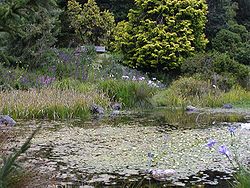| San Francisco Botanical Garden at Strybing Arboretum | |
|---|---|
| Strybing Arboretum | |
 San Francisco Botanical Garden | |
| Type | Botanical garden |
| Location | Golden Gate Park [1] |
| Area | 55 acres (22 ha) [1] |
| Opened | 1940 [1] |
| Operated by | San Francisco Recreation & Parks Department |
| Visitors | Over 450,000 Annual Visits |
| Status | Open year round |
| Public transit access | |
| Website | gggp |
The San Francisco Botanical Garden at Strybing Arboretum (formerly Strybing Arboretum) is located in San Francisco's Golden Gate Park. Its 55 acres (22.3 ha) represents nearly 9,000 different kinds of plants from around the world, with particular focus on Magnolia species, high elevation palms, conifers, and cloud forest species from Central America, South America and Southeast Asia. [2]
Contents
San Francisco's County Fair Building is located near the main entrance to the Garden.
The San Francisco Botanical Garden is now one of the three locations of the Gardens of Golden Gate Park, along with the Japanese Tea Garden and the Conservatory of Flowers. [3]















